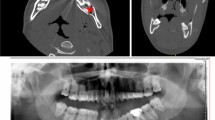Abstract
Mandibular fractures are frequently encountered in the trauma setting and comprise a significant number of facial injuries. The purpose of this study was to evaluate the prevalence and injury patterns of unifocal and multifocal mandibular fractures using thin-section imaging. Following IRB approval, 220 patients with mandibular fractures identified on maxillofacial CT scans performed between October 2008 and February 2011 were retrospectively reviewed. Examinations were performed on 64-multidetector row CT scanners with axial images acquired at 1.25-mm slice thickness. The location and number of fractures as well as causative mechanisms were recorded. Fractures were unifocal in 108/220 (49 %) and multifocal in 112/220 (51 %) patients. The mandibular angle was the most common fracture site in both unifocal and multifocal mandible fractures. In cases with multifocal mandibular fractures, bilateral fractures were more common (83 %) than unilateral multifocal mandibular fractures (17 %). Fractures involving the parasymphysis, the mandibular body, or ramus were significantly associated with the presence of additional mandibular fractures (p < 0.0001). While multifocal and unifocal fractures occurred in near equal frequency, bilateral multifocal fractures were much more common than unilateral multifocal mandibular fractures. Alveolar ridge fractures were exclusively seen in unifocal mandibular fractures.


Similar content being viewed by others
References
Gassner R, Tuli T, Hächl O, Rudisch A, Ulmer H (2003) Craniomaxillofacial trauma: a 10 year review of 9,543 cases with 21,067 injuries. J Craniomaxillofac Surg 31:51–61
King RE, Scianna JM, Petruzzelli GJ (2004) Mandible fracture patterns: a suburban trauma center experience. Am J Otolaryngol 25:301–307
Roth FS, Kokoska MS, Awwad EE, Martin DS, Olson GT, Hollier LH, Hollenbeak CS (2005) The identification of mandible fractures by helical computed tomography and panorex tomography. J Craniofac Surg 16:394–399
Halazonetis JA (1968) The ‘weak’ regions of the mandible. Br J Oral Surg 6:37–48
Rajput D, Bariar LM (2013) Study of maxillofacial trauma, its aetiology, distribution, spectrum, and management. J Indian Med Assoc 111:18–20
Escott EJ, Branstetter BF (2008) Incidence and characterization of unifocal mandible fractures on CT. AJNR Am J Neuroradiol 29:890–894
Abdullah WA, Al-Mutairi K, Al-Ali Y, Al-Soghier A, Al-Shnwani A (2013) Patterns and etiology of maxillofacial fractures in Riyadh City, Saudi Arabia. Saudi Dent J 25:33–38
Hagan EH, Huelke DF (1961) An analysis of 319 case reports of mandibular fractures. J Oral Surg Anesth Hosp Dent Serv 19:93–104
Ogundare BO, Bonnick A, Bayley N (2003) Pattern of mandibular fractures in an urban major trauma center. J Oral Maxillofac Surg 61:713–718
Goodday RH (2013) Management of fractures of the mandibular body and symphysis. Oral Maxillofac Surg Clin North Am 25:601–616
Chrcanovic BR, Freire-Maia B, Souza LN, Araújo VO, Abreu MH (2004) Facial fractures: a 1 year retrospective study in a hospital in Belo Horizonte. Braz Oral Res 18:322–328
Rashid A, Eyeson J, Haider D, van Gijn D, Fan K (2013) Incidence and patterns of mandibular fractures during a 5-year period in a London teaching hospital. Br J Oral Maxillofac Surg 51:794–798
Natu SS, Pradhan H, Gupta H, Alam S, Gupta S, Pradhan R, Mohammad S, Kohli M, Sinha VP, Shankar R, Agarwal A (2012) An epidemiological study on pattern and incidence of mandibular fractures. Plast Surg Int 2012:834364
Boole JR, Holtel M, Amoroso P, Yore M (2001) 5196 mandible fractures among 4381 active duty army soldiers, 1980 to 1998. Laryngoscope 111:1691–1696
Carlin CB, Ruff G, Mansfeld CP, Clinton MS (1998) Facial fractures and related injuries: a ten year retrospective analysis. J Craniomaxillofac Trauma 4:44–48
Fridrich KL, Pena-Velasco G, Olson RA (1992) Changing trends with mandibular fractures: a review of 1,067 cases. J Oral Maxillofac Surg 50:586–589
Olson RA, Fonseca RJ, Zeitler DL, Osbon DB (1982) Fractures of the mandible: a review of 580 cases. J Oral Maxillofac Surg 40:23–28
Scherer M, Sullivan WG, Smith DJ Jr, Phillips LG, Robson MC (1989) An analysis of 1,423 facial fractures in 788 patients at an urban trauma center. J Trauma 29:388–390
Haug RH, Prather J, Indresano AT (1990) An epidemiologic survey of facial fractures and concomitant injuries. J Oral Maxillofac Surg 48:926–932
Braasch DC, Abubaker AO (2013) Management of mandibular angle fracture. Oral Maxillofac Surg Clin North Am 25:591–600
Shen L, Li J, Li P, Long J, Tian W, Tang W (2013) Mandibular coronoid fractures: treatment options. Int J Oral Maxillofac Surg 42:721–726
Kisnisci R (2013) Management of fractures of the condyle, condylar neck, and coronoid process. Oral Maxillofac Surg Clin North Am 25:573–590
Agnihotri A, Prabhu S, Thomas S (2014) A comparative analysis of the efficacy of cortical screws as lag screws and miniplates for internal fixation of mandibular symphyseal region fractures: a randomized prospective study. Int J Oral Maxillofac Surg 43:22–28
Dingman RO, Natvig P (1964) Surgery of facial fractures. WB Saunders, Philadelphia, pp 142–145
Sinn CA, Hill SC, Watson SW (1987) Mandibular fractures. In: Foster CA, Sherman JE (eds) Surgery of facial bone fractures. Churchill Livingstone, New York, pp 177–178
Greene D, Raven R, Carvalho G, Maas CS (1997) Epidemiology of facial injury in blunt assault. Determinants of incidence and outcome in 802 patients. Arch Otolaryngol Head Neck Surg 123:923–928
Author information
Authors and Affiliations
Corresponding author
Ethics declarations
This study was approved by the institutional review board.
Conflict of interest
The authors declare that they have no conflict of interest.
Rights and permissions
About this article
Cite this article
Buch, K., Mottalib, A., Nadgir, R.N. et al. Unifocal versus multifocal mandibular fractures and injury location. Emerg Radiol 23, 161–167 (2016). https://doi.org/10.1007/s10140-015-1375-9
Received:
Accepted:
Published:
Issue Date:
DOI: https://doi.org/10.1007/s10140-015-1375-9




